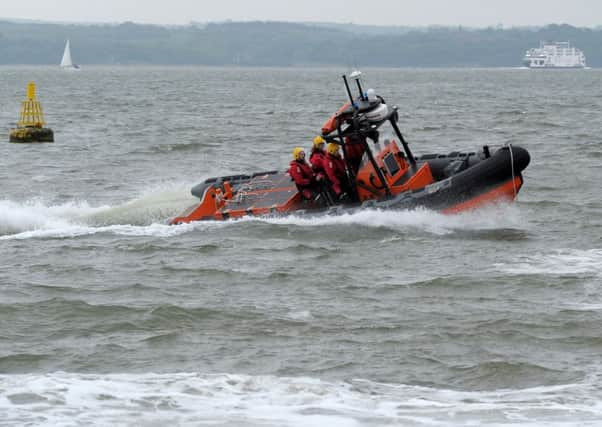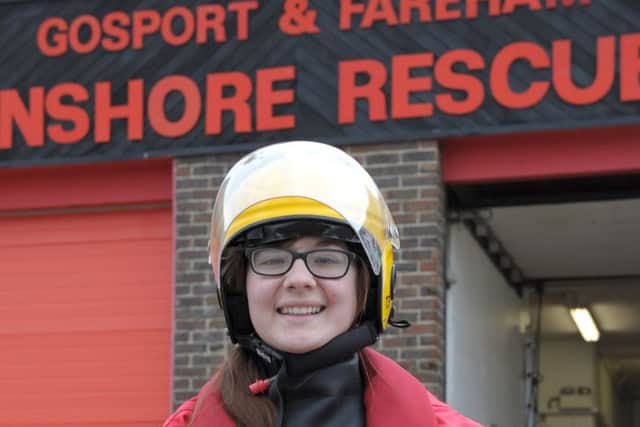Lifeboat service Gafirs is always ready to rescue
This article contains affiliate links. We may earn a small commission on items purchased through this article, but that does not affect our editorial judgement.


For independent lifeboat service the Gosport and Fareham Inshore Rescue Service (Gafirs), helping keep people safe while at sea is something it does 24 hours a day, every day of the year.
The volunteer organisation, based in Gosport, is part of the Coastguard Service and operates in the Solent, helping with a range of rescues.
Advertisement
Hide AdAdvertisement
Hide AdThe crew can get called to help stranded yachts, provide medical assistance in emergency situations and help search for missing people.


So far this year, they have responded to 45 incidents.
Based off Lifeboat Lane, at Stokes Bay, Gafirs relies solely on its volunteers who are on call and respond to incidents no matter what the time.
On average, it takes just 12 minutes for the lifeboat to be launched from when the crew are first paged.
Vice-chairman Mike Allen has been with Gafirs for the past 40 years. He joined as teenager and has enjoyed helping out since.


Advertisement
Hide AdAdvertisement
Hide AdThe 54-year-old says: ‘You never know what is going to happen at Gafirs.
‘I enjoy that it’s so unpredictable. Sometimes there is so much going on in terms of events or boats on the water and you expect it to be busy but it is quiet.
‘For some events, we do have more people available because they are more high-risk. We need to be prepared when we can.
‘But you never know what is going to happen next.
‘I also enjoy helping people and this is my way of helping others.
Advertisement
Hide AdAdvertisement
Hide Ad‘There are some people around today who would not be if it wasn’t for the intervention of Gafirs.
‘They are extremely grateful – as are their families.
‘Over the years there have been tragedies, but there have also been some excellent rescues carried out.’
Although the amount of rescues Gafirs goes on every year has remained near enough the same, the type of incidents have got more serious. It can help the police look for missing people or work with the helicopter teams if someone needs urgent medical care.
Mike adds: ‘As time has gone on, we have started to respond to more serious incidents.
Advertisement
Hide AdAdvertisement
Hide Ad‘In the past, it would have been dinghy rescues or small vessels but now we attend a range of rescues and incidents.’
To help with the range of incidents responded to, Gafirs has recently got a new lifeboat. The money was from a bequest and also enabled a new tractor to be bought.
The new lifeboat, called The Joan Dora Fuller, is due to be unveiled at the Gafirs headquarters today at 2pm.
SUPPORT FROM THE PUBLIC
PROVIDING cover throughout the year means Gafirs relies on support from the public to help with their costs.
Advertisement
Hide AdAdvertisement
Hide AdEveryone involved in the lifeboat service is a volunteer from the crew to the directors.
But they still need money for the upkeep of their equipment.
Gafirs does receive money from the Lifeboat Lotto and holds fundraisers throughout the year to boost donations.
One of their biggest events is their New Years Day swim. Every year, thousands of people take a swim in the Solent, some dressed in costumes and others braving their cold in swimwear. As well as raising money for Gafirs, the day also raises cash for other charities.
Advertisement
Hide AdAdvertisement
Hide AdVice-chairman of Gafirs, Mike Allen says: ‘We totally rely on public support and donations.
‘Gafirs would not be able to run if is wasn’t for the community helping us out.
‘One thing we really try to impress on the community is that we are an independent lifeboat service.
‘We are not part of the RNLI and that is an important message we need to get across. We really do need help with donations.’
KEEP UP TO DATE ONLINE
Advertisement
Hide AdAdvertisement
Hide AdKEEPING people up-to-date with what they do everyday is something Gafirs is keen to do.
When they attend incidents, they post details on their Facebook page.
They also have a website dedicated to their fundraiser efforts and explaining who they are and what they do.
For their Facebook page visit facebook.com/GAFIRS. For their website visit gafirs.org.uk
MY TIME AT SEA WITH GAFIRS
Advertisement
Hide AdAdvertisement
Hide AdSPENDING the morning with some of the volunteers from the Gosport and Fareham Inshore Rescue Service (Gafirs) was an eye-opener into just how much water they cover and the range of incidents they are called to.
The crew, based at Stokes Bay, patrol the Solent from Hill Head along the coast to Gunwharf Quays and Eastney and out to the Solent Forts.
With their new lifeboat, the time it takes to get from A to B is a matter of minutes - something which is crucial in their line of work.
I was excited when I got the offer to go out with the crew and see what they do first-hand.
Advertisement
Hide AdAdvertisement
Hide AdJoined by volunteers James Baggott and Jake Robinson and coxswain Pete Byford, I was showed what Gafirs do on an operational day when they patrol the sea.
We headed straight out into the Solent which, considering it was a grey Saturday morning, was busy with yachts and powerboats passing by.
I am told that as the weather gets warmer, the Solent gets busier with more people taking their boats out. Gafirs prepares for busier days with extra people on-call during bank holiday weekends or during busy sailing events like Cowes Week.
We head east towards Portsmouth and the Solent Forts which occasionally call on help from Gafirs. With the hotels situated in the middle of the sea if emergency care is needed, Gafirs will respond.
Advertisement
Hide AdAdvertisement
Hide AdOn our way to the Solent Forts, we spot a lobster trap floating on the surface of the water.
Pete tells me they can cause trouble for boats who do not see them and end up sailing into them. The basket can get caught on the propeller and cause serious damage. I can see why - the trap is small and coloured black with just the top half visible above the water.
We move on and I can see Old Portsmouth with the Round Tower before being zipped away as we travel along the Southsea coastline.
During this time, I am shown the technology on board the lifeboat which is key in locating boats or seeing what depth the water is at. James explains to me the use of the radio and how the Coastguard is updated every 15 minutes with their position. Their new lifeboat has a timer whereas before they relied on checking their watches to give the update.
Advertisement
Hide AdAdvertisement
Hide AdBut it is not just the new electronics which makes the boat better than the last. It can also turn in tight circles so if someone is in the water, the lifeboat is never too far from them even when it changes direction.
For me though, the speed of the lifeboat is its most impressive feature. The Gafirs crew are saving lives and speed is important. It can be a matter of minutes between the lifeboat getting to a sinking yacht or a yacht that has already sunk.
As we head back from Southsea to Stokes Bay, the engines are put in full throttle and we speed across the water. Luckily, the helmet I have on has a visor to keep the spray out of my face.
We get to the beach at Stokes Bay and the on-shore volunteers help back the boat onto a trailer. That also happened surprisingly quickly and as I am helped off the boat and back onto dry land, I realise just how crucial the work is that Gafirs does.
Advertisement
Hide AdAdvertisement
Hide AdThanks to their speed and efficiency, they are usually the first rescue service at an incident and its all because of their dedicated volunteers. ELLIE PILMOOR
GAFIRS FACT FILE
1. Gafirs was founded in 1969 following a tragic drowning in Stokes Bay.
2. Lifeboats, crew and short team are on with the Coastguard 24 hours a day, every day of the year.
3. It is an independent service and just one of 64 independent lifeboat stations in the UK.
Advertisement
Hide AdAdvertisement
Hide Ad4. It takes on average 12 minutes from Gafirs being paged for the lifeboat to be launched.
5. Everyone involved in Gafirs from the lifeboat crew to the directors are volunteers and do not get paid for their services.
6. Members come from all walks of life from IT specialists to people running their own businesses.
7. Gafirs relies on donations from the public to help keep the service going. The Lifeboat Lotto provides a regular monthly income.
Advertisement
Hide AdAdvertisement
Hide Ad8. The service is part of the Solent Sea Rescue Organisation which is a Hampshire County Council initiative.
9. Before moving to their headquarters at Lifeboat Lane, Gafirs was based in an old Victorian deckchair store next to Stokes Bay Sailing Club.
10. On a typical operational day, Gafirs will patrol the Solent for two hours.